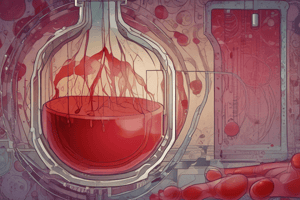Podcast
Questions and Answers
Explain what "von Hippel-Lindau disease" is. Indicate morphologic features of von Hippel-disease
Explain what "von Hippel-Lindau disease" is. Indicate morphologic features of von Hippel-disease
Von Hippel-Lindau (VHL) disease is a rare, inherited disorder caused by mutations in the VHL gene, leading to the formation of benign and malignant tumors in multiple organs. Morphologic features: Hemangioblastomas, Renal cell carcinoma, Pheochromocytomas, Pancreatic cysts
Explain microscopic histology of schwannoma and neurofibroma
Explain microscopic histology of schwannoma and neurofibroma
Schwannoma has mixed cellularity, palisading pattern Neurofibroma has wavy spindle cells, encapsulated
Explain why it is important with grading and deactivated grades
Explain why it is important with grading and deactivated grades
Grading assesses tumor differentiation, guiding prognosis, treatment, and disease monitoring.
Deactivated grades are outdated systems replaced by standardized methods for accuracy and consistency.
Describe macroscopic and microscopic structure of glioblastoma
Describe macroscopic and microscopic structure of glioblastoma
Indicate and describe microscopic and macroscopic morphologic features and molecular immunohistochemical profile of astrocytoma
Indicate and describe microscopic and macroscopic morphologic features and molecular immunohistochemical profile of astrocytoma
Indicate and describe general morphologic features of metastatic neoplasms of brain
Indicate and describe general morphologic features of metastatic neoplasms of brain
Explain what "neurofibromatosis" is. Indicate and describe classifications of neurofibromatosis
Explain what "neurofibromatosis" is. Indicate and describe classifications of neurofibromatosis
Schwannoma affects which of the following?
Schwannoma affects which of the following?
What are the macroscopic morphologic features and molecular immunohistochemical profiles that differentiate astrocytoma from oligodendroglioma?
What are the macroscopic morphologic features and molecular immunohistochemical profiles that differentiate astrocytoma from oligodendroglioma?
What are some complications of cerebral neoplasms?
What are some complications of cerebral neoplasms?
Grade 1
Grade 1
Grade 2
Grade 2
Grade 3
Grade 3
Grade 4
Grade 4
Astrocytoma location
Astrocytoma location
Name the 3 types of meningioma and describe them.
Name the 3 types of meningioma and describe them.
Flashcards
Capital of France (example flashcard)
Capital of France (example flashcard)
Paris



